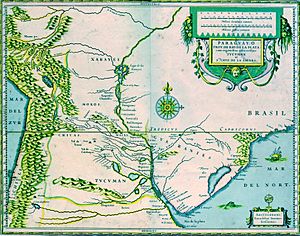Bahía Negra facts for kids
Quick facts for kids
Bahía Negra
|
|
|---|---|
|
District
|
|
| Country | Paraguay |
| Department | Alto Paraguay |
| Time zone | -4 Gmt |
Bahía Negra is a small town, also called a district, in the Alto Paraguay area of Paraguay. It sits right on the western side of the Paraguay River. As of 2023, about 2,537 people live there.
Location
Bahía Negra is in the far northeast part of the Alto Paraguay area. It is about 137 kilometers (85 miles) north of Fuerte Olimpo, which is the main city of the department. The town is located at 20°15'00"S latitude and 58°12'00"W longitude. It is about 75 meters (246 feet) above sea level.
The name "Bahía Negra" means "Black Bay." This refers to a wide bend in the Paraguay River that looks like a bay. This bend goes into the Chaco Boreal region. The land on the western side of the river has higher cliffs where people have built towns. The eastern side, which is now in Brazil, is low and covered by wetlands. These wetlands are part of the huge Pantanal area.
Just north of Bahía Negra, the border between Bolivia, Brazil, and Paraguay meets. The border with Bolivia follows the Otuquis wetlands and the Bambural River (also called the Negro River in Paraguay).
Climate
The weather in Bahía Negra is known as a tropical savanna climate. This means it has hot temperatures all year, with a wet season and a dry season.
History
Long ago, before the Spanish arrived in the 1500s, different groups of native people lived in this area. These included the iśir people, also known as "zamucos" or "chamacocos." There were also some Guarani-speaking groups and later the Caduveo people.
The first Spanish explorers came to this land in the 1530s. Captains Juan de Ayolas and Domingo Martínez de Irala were among them. They built a fort called La Candelaria in 1537, but it was later left empty. In 1543, Irala founded another town called "Puerto de los Reyes," but it was also abandoned. Later, in 1568, Ñuflo de Chaves, who founded Santa Cruz de la Sierra, was killed near here.
In the 1600s, groups from Brazil called Bandeirantes started to raid the area. This caused the Spanish to leave some of their towns and missions. Many forts were built along the Paraguay River in the 1700s to protect the land. One important fort was Fort Borbón, built in 1792.
After independence of Paraguay in the early 1800s, Paraguay claimed this northern Chaco region. However, Brazil also had military power in the area. By 1864, the effective border for Paraguay was the Negro or Bambural River.
After the War of the Triple Alliance (1864-1870), the borders became even more complicated. Brazil occupied parts of the Paraguay River banks. In 1885, Bolivia's president, Gregorio Pacheco, founded a port called Puerto Pacheco on the Paraguay River. Paraguayan forces took control of it in 1888, but it was returned to Bolivia in 1894.
Later, in 1903, after another conflict, Brazil "recognized" Bolivia's claim over the Chaco Boreal. This happened even though Brazil didn't really have rights to the land south of a certain line. Paraguay's president, Juan Antonio Escurra, protested this.
In 1907, Paraguayan forces took the port again, but the Bolivian army got it back in 1915. These disagreements were some of the reasons for the very difficult Chaco War (1932-1935). After this war, it was finally agreed that Bahía Negra would be part of Paraguay.
On April 25, 2005, Bahía Negra officially became a municipality. This made it the 233rd municipality in Paraguay.
Economy
Bahía Negra has a river port, which is a place where boats can load and unload goods. There are also warehouses to store products from the region. Some small factories process local goods like wood, soybeans, and leather. People also do a bit of fishing.
A very important activity here is cattle ranching, raising cows for meat and other products. There is also potential for tourism. Near the border with Bolivia, you can find the Río Negro national park. This park is home to many amazing animals like jaguars, caimans (like alligators), capybaras, peccaries (wild pigs), black howler monkeys, maned wolves, pumas, and giant otters.
See also
 In Spanish: Bahía Negra para niños
In Spanish: Bahía Negra para niños


